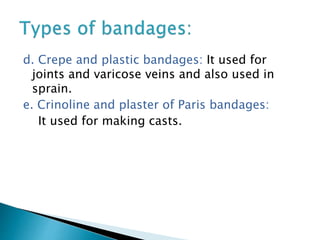Bandaging Basics For Nursing Students
- 2. A bandage is a piece of material used either to support a medical device such as dressing or splint, or on its own to provide support to or to restrict the movement of a part of the body. Or, A Bandage is defined as a piece of gauze or other materials used for wrapping, binding up and support or immobilized a part of the body.
- 3. Bandaging is the process of covering a wound or injured part using various materials such as gauze, elasticized knit, flannel or muslin. Or, Bandaging is a process which applied to the injured part of the body or to limb for immobilize, binding up and secure to support.
- 4. A. Triangular bandage: It is used for slings. B. Roller bandage: It is used for bandaging any part of the body. C. Special bandages: a. Many tailed bandages: It used as abdominal binder. b. Four tailed bandages: It used for bandaging the chin or jaw bandage.
- 5. c. T bandage: It used holding dressing over perineum.
- 6. d. Crepe and plastic bandages: It used for joints and varicose veins and also used in sprain. e. Crinoline and plaster of Paris bandages: It used for making casts.
- 7. 1. To fix and retain dressing or splint in a position. 2. To give support to an injured part. 3. To apply pressure to stop bleeding/hemorrhage. 4. To prevent and reduce swelling. 5. To immobilize an injured part so as to relive pain. 6. To prevent contamination of a wound. 7. To secure splints in position.
- 8. 8. To retain warmth. 9. To correct hemorrhage by means of pressure. 10. To correct deformity. 11. To absorb discharge. 12. To prevent infection and avoid further injury. 13. To restrict movement. 14. To provide physical comfort.
- 9. 1.Roller bandage- Uses for hand, thumb, palm, finger, elbow, eye, ear, and cape-line bandage for the head.
- 10. 2. Triangular bandage: It is used in the different part of the body such as for the scalp, hand, eye, cheek, front or back of the chest, for the shoulder, elbow, knee, foot, hip and groin and for the sling.
- 11. 3. Collar and cuff sling: This is used to support the wrist only.
- 12. 4. Triangular sling: The sling is used to treating a fracture of the collar bone.
- 13. 5. Many tailed bandage: Used as chest and abdominal area for the support.
- 14. 6. Crepe or elastic bandages: this is comfortable and give good support .uses in joints, varicose veins and sprains.
- 15. 7. Plaster: It used for fracture in the limbs or long bone of the lower limbs, upper limbs, femur.
- 16. 8. Rubber bandage: Used to control and prevent bleeding but should not applied more than 30 minutes at a time.
- 17. 1. Place the patient and the injured part which is to be bandaged in comfortable position. 2. Apply bandages when patient is sitting or lying down position. 3. Injured part should be well supported in position. 4. Bandaging are never applied directly over wounds. 5. Avoid pressure over painful area. 6. The bandage should not be very loose or tight. 7. Bandage always should be neat and clean.
- 18. 8.Never use dirty or wet or unroll bandage. 9. Use a tightly roller bandages of the correct width. 10. Support the part to be bandaged throughout the procedure. 11. Always stand in front of the patient, except when applying cape-line bandage. 12. Bandage a limb in the position in which it is to remain. E.g.- forearm and hand should be prone.
- 19. 13. Hold the bandage with the head of roll uppermost and apply the outer surface of the bandage to the part, never unroll more than a few inches of bandages at a time. 14. Apply bandage from medical outwards and from below upwards maintaining even pressure throughout. 15. Begin the bandage with a firm oblique turn to fix it and below each successive turn to cover two thirds of the previous one with the free edges lying parallel.
- 20. 16. Make any reverse or crossing line on the outer side of the limb except, when this brings the bandage over a wound or bony prominence, in which case, it must be on the front of the limb. 17. Pad the axilla or groin when bandaging these parts , so that two surfaces of skin do not touch each other beneath the bandage. 18. Finish off with a straight turn above the part, hold the end and fasten with the saftey pin.
- 21. 1. Have the patient in a comfortable position either sitting up or lying down. 2. Choose the right bandage according to the site. 3. Stand opposite the patient and on the same site of the part to be bandaged except in cases of cape-line and neck bandages. Be comfortable yourself. 4. Place and support the limb in the correct position,
- 22. 5. See that the part is free from perspiration. If necessary wash, dry and apply powder. 6. Place the bandage against the skin, seeing that the roll remains upper most. 7. Keep skin surfaces apart and allow no turn over bony prominences. 8. Bandage from below upward from within outward and over the front of the limb. 9. Fix the beginning of the bandage with a circular turn; each succeeding turn should overlap two thirds of the previous turn.
- 23. 10. Keep all margins parallel and let the crossing and reversing be in one line towards the outer aspects. 11. Keep the pressure uniform throughout leave fingers and toes exposed where possible, so skin of any can be directed. 12. Finish by securing the ends needs neatly with a circular turn.






















